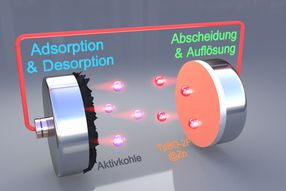Reversible mechanism that increases muscle elasticity
How does yoga improve your flexibility? In the Mar 13 cover story of Cell, Columbia University biological sciences professor Julio Fernandez and team report the discovery of a new form of mechanical memory that adjusts the elasticity of muscles to their history of stretching. Using highly sensitive atomic force microscopes, the researchers detected a chemical reaction that increases the elasticity of muscle proteins. Crucially, this reaction targets molecules that have been exposed to a stretching force. This finding changes our understanding of how muscles respond to stretching and may lead to new treatments of muscle disorders.
"We discovered an effective way of tuning muscle elasticity," says Pallav Kosuri, one of the lead authors. "We first observed the effect on a molecular level, and then tested it all the way up to human tissue."
Julio Fernandez has spent nearly two decades studying the molecular origin of muscle elasticity, pioneering single-molecule techniques that today are widely used to study the mechanics of molecules. One molecule in particular captured his attention: a protein called titin. The largest protein in the body, titin is also the main source of passive muscle elasticity. Each titin molecule consists of a long chain of folded bundles resembling a rope with hundreds of knots. Titin has traditionally been regarded as a passive structural scaffold for muscle; however, research done in the Fernandez lab reveals that there is more to titin than meets the eye. "Titin is a mechanical computer that provides the right elastic output to every single muscle in our body, including the heart," says Fernandez. "Making sure this computer works at optimal performance is among the most formidable challenges the human body has to meet."
In the new study, lead authors Jorge Alegre-Cebollada and Kosuri investigated how titin elasticity is affected by oxidation. Oxidation levels increase during muscle activity as a natural consequence of elevated metabolism. The researchers found that titin contains an unusually high number of oxidation hotspots – locations that are prone to oxidation – but that most of these spots are hidden inside molecular folds and are therefore inactive. However, stretching a muscle can force titin to unfold. The authors found that such unfolding exposed the hotspots, causing titin to become increasingly sensitive to oxidation when stretched. Intrigued by this observation, the team set out to investigate what happens to titin once it becomes oxidized. They focused on one of the most common forms of oxidation, called glutathionylation.
The researchers observed that, as they had expected, mechanical force unraveled the folded bundles in titin and enabled glutathionylation. The surprise came when they found that this type of oxidation locks the bundles in an unfolded state, causing the stiffness of titin to drop dramatically. In the absence of oxidation, mechanical force can only generate transient changes in elasticity, lasting a few seconds at most. However, the effect of a mechanical force in combination with glutathionylation was much more persistent – the stiffness of the titin molecules could only be reset by reversing the oxidation.
Putting these pieces together can explain why the combination of exercising and stretching leads to long-lasting yet reversible increases in flexibility. Exercising facilitates oxidation reactions, but it is stretching that primes the muscle for oxidation. Once oxidation reactions occur, they lock the muscle proteins in an unfolded state and cause sustained increases in their elasticity. The muscle goes back to normal when the muscle cells naturally remove the oxidation, a process that can take several hours. "As a yoga aficionado, I believe that we are starting to understand the increase in flexibility induced by yoga," says Alegre-Cebollada. "A pose like downward-facing dog is a highly effective way to unfold the knots in titin, enabling modifications that make the protein remember that it has to remain unfolded and soft." Fernandez and team speculate that this type of mechanical memory could be a common feature of most elastic tissues.
Clinically, the discovery points to the potential of using biochemical means to alter muscle elasticity. Such pharmacological tuning of muscle mechanics could lead to new treatments for heart disease and other conditions that affect muscle elasticity, including dilated cardiomyopathy, one of the most common causes of heart failure in young people. "This is an initial discovery, but the implications are very exciting," says Kosuri. "And it shows that we still have much to learn about how our muscles really work."























































